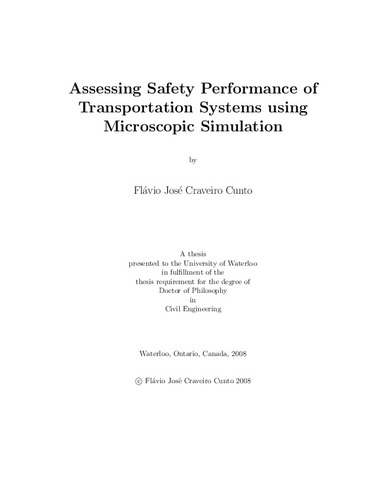UWSpace will be migrating to a new version of its software from July 29th to August 1st. UWSpace will be offline for all UW community members during this time.
Assessing Safety Performance of Transportation Systems using Microscopic Simulation
| dc.contributor.author | Cunto, Flávio | |
| dc.date.accessioned | 2008-11-06 15:43:28 (GMT) | |
| dc.date.available | 2008-11-06 15:43:28 (GMT) | |
| dc.date.issued | 2008-11-06T15:43:28Z | |
| dc.date.submitted | 2008 | |
| dc.identifier.uri | http://hdl.handle.net/10012/4111 | |
| dc.description.abstract | Transportation safety has been recognized as a public health issue worldwide, consequently, transportation researchers and practitioners have been attempting to provide adequate safety performance for the various transportation components and facilities to all road users given the usually scarce resources available. Safety engineers have been trying to make decisions affecting safety based on the knowledge extracted from different types of statistical models and/or observational before-after analysis. It is generally recognized that this type of factual knowledge is not easily obtained either statistically or empirically. Despite the intuitive link between road safety and observed crashes, a good understanding of the sequence of events prior to the crash can provide a more rational basis for the development of engineering countermeasures. The development of more comprehensive mechanistic models for safety assessment is heavily dependent on detailed vehicle tracking data that is not readily available. The potential of microscopic simulation in traffic safety and traffic conflict analysis has gained increasing interest mostly due to recent developments in human behaviour modelling and real-time vehicle data acquisition. In this thesis, we present a systematic investigation of the use of existing behavioural microscopic simulation models in short-term road safety studies. Initially, a microscopic framework is introduced to identify potentially unsafe vehicle interactions for different vehicle movements based on three types of traffic behaviour protocols: car-following, lane change and gap acceptance. This microscopic model for safety assessment applies a safety performance measure based on pairwise comparisons of spacing and speed differential between adjacent vehicles and individual braking power in real-time. A calibration/validation procedure using factorial analysis is presented to select best model input parameters for this safety performance measure by using high resolution vehicle tracking data. The ability of the proposed safety performance measure to reflect real-life observed high-risk vehicular interactions is explored in three intuitive tests using observed crash data. Finally, the usefulness of the model is illustrated through its application to investigate the safety implications of two different geometric and operational traffic strategies. The overall results indicate that, notwithstanding the fact that actual behavioural microscopic algorithms have not been developed strictly to model crashes, they are able to replicate several factors directly related to high risk situations that could lead to crashes with reasonable accuracy. With the existing upward trend in computing power, modelling techniques and increasing availability of detailed vehicle tracking data, it is likely that safety studies will be carried out using a more mechanistic and inclusive approach based on disruptive driving behaviour rather than ultimate unpredictable and heavily restrictive crash events. | en |
| dc.language.iso | en | en |
| dc.publisher | University of Waterloo | en |
| dc.subject | microscopic simulation | en |
| dc.subject | safety performance measures | en |
| dc.subject | road safety | en |
| dc.subject | surrogate safety measures | en |
| dc.title | Assessing Safety Performance of Transportation Systems using Microscopic Simulation | en |
| dc.type | Doctoral Thesis | en |
| dc.pending | false | en |
| dc.subject.program | Civil Engineering | en |
| uws-etd.degree.department | Civil and Environmental Engineering | en |
| uws-etd.degree | Doctor of Philosophy | en |
| uws.typeOfResource | Text | en |
| uws.peerReviewStatus | Unreviewed | en |
| uws.scholarLevel | Graduate | en |

